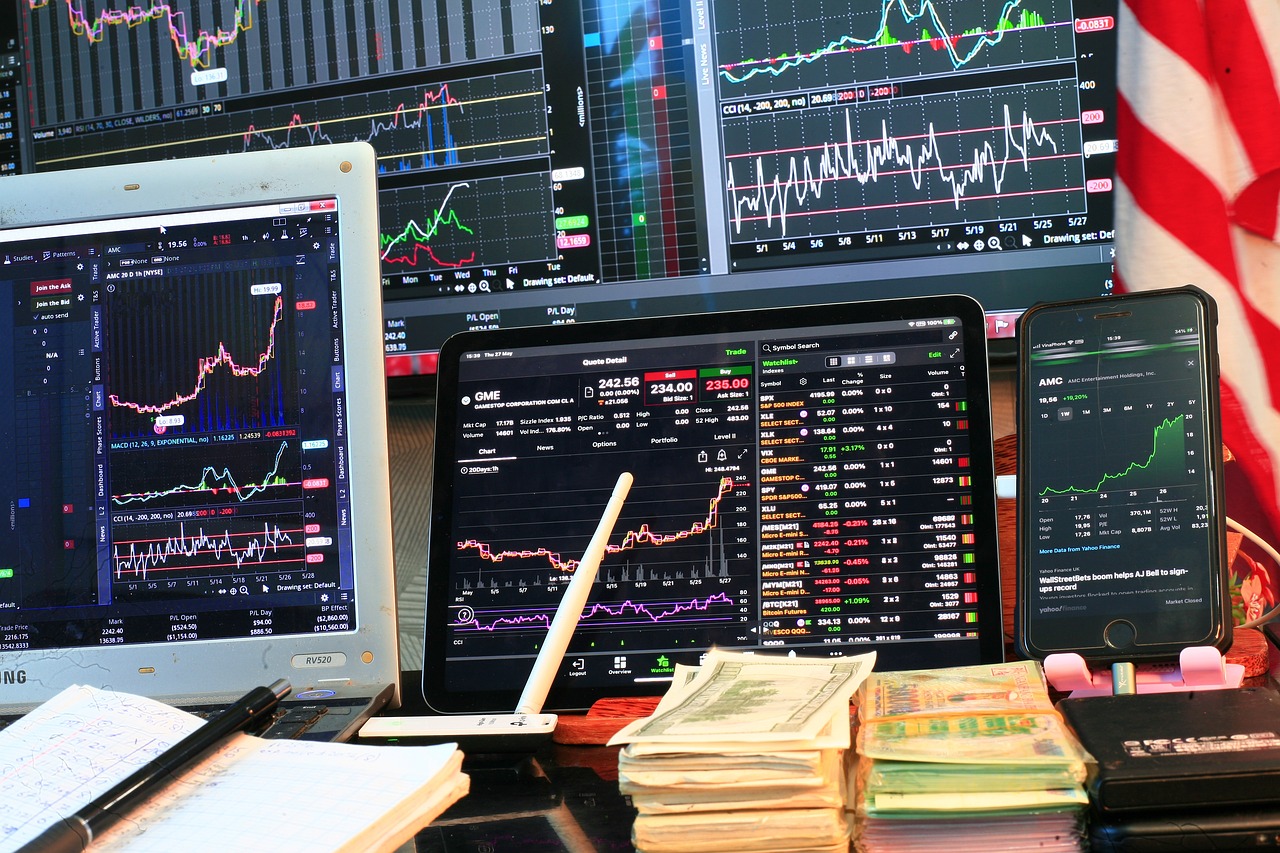How to Use Moving Averages in Crypto Trading
In the fast-paced world of cryptocurrency, making informed trading decisions is crucial. One of the most effective tools at a trader's disposal is the concept of moving averages. These indicators help smooth out price fluctuations, allowing traders to identify trends and make better predictions about future price movements. But how exactly do moving averages work, and how can they be effectively utilized in your trading strategy? This article will guide you through the fundamentals of moving averages, their types, and practical applications in the realm of crypto trading.
Moving averages are fundamental indicators in trading. They serve as a statistical method to smooth out price data over a specified period, providing a clearer picture of market trends. By averaging the price over a set number of days, moving averages help traders discern the overall direction of the market, whether it’s trending upwards, downwards, or moving sideways. This makes them invaluable for identifying potential entry or exit points in a trade. Imagine riding a wave; moving averages help you catch the right wave at just the right moment, enhancing your chances of success in the turbulent waters of crypto trading.
There are several types of moving averages, each with its unique characteristics and applications. The two most commonly used are the Simple Moving Average (SMA) and the Exponential Moving Average (EMA). These moving averages can significantly influence trading decisions, depending on the market conditions and the trader's strategy. Understanding the differences between them is essential for maximizing their effectiveness in your trading endeavors.
The Simple Moving Average (SMA) calculates the average price over a specified period, such as 10, 20, or 50 days. It is widely used for identifying trends and is particularly effective in stable market conditions. The SMA provides a straightforward view of price trends, making it easier for traders to spot potential support and resistance levels. For instance, if the price consistently stays above the SMA, it may indicate a bullish trend, while a price below the SMA could suggest a bearish trend. However, it’s crucial to remember that while the SMA can be a powerful tool, it has its limitations.
The SMA offers several benefits, including:
- Clarity: It provides a clear view of price trends, helping traders make informed decisions.
- Support and Resistance Levels: SMA can help identify critical levels where prices may reverse.
- Long-term Strategies: It is particularly useful for traders who prefer a long-term approach to trading.
While the SMA is a valuable tool, it does have its drawbacks. One significant limitation is its tendency to lag in fast-moving markets. This lag can cause traders to miss critical price movements, leading to missed opportunities. Therefore, understanding the limitations of SMA is essential for effective trading. It’s important to combine it with other indicators or tools to confirm signals and enhance trading accuracy.
The Exponential Moving Average (EMA) is another popular moving average that gives more weight to recent prices. This characteristic makes the EMA more responsive to new information compared to the SMA. As a result, traders may receive earlier signals when using the EMA, which can be particularly advantageous in volatile markets. The faster reaction of the EMA can help traders capitalize on short-term price movements, making it a favorite among day traders and those looking for quick profits.
Incorporating moving averages into your trading strategies can significantly enhance your decision-making process. Traders often use techniques such as crossovers to identify potential buy or sell signals. A moving average crossover occurs when a short-term average crosses above or below a long-term average. For example, if the 50-day EMA crosses above the 200-day EMA, it may signal a bullish trend, prompting traders to consider entering a long position. Conversely, a cross below may indicate a bearish trend, suggesting it’s time to sell.
Moving average crossovers are among the most popular strategies used by traders. They can provide clear signals for entering or exiting trades. However, it’s essential to confirm these signals with additional analysis or indicators to avoid false alarms. Think of it as having a trusted friend verify your plans before you go ahead; it adds an extra layer of confidence to your trading decisions.
Integrating moving averages with other technical indicators can provide a more comprehensive view of market conditions. For instance, combining the EMA with the Relative Strength Index (RSI) can help traders identify overbought or oversold conditions, enhancing the effectiveness of trading strategies. By using multiple indicators, traders can create a robust strategy that minimizes risks and maximizes potential rewards.
Despite their usefulness, traders often make mistakes when using moving averages. One common pitfall is relying solely on them without considering the broader market context. Awareness of these mistakes can significantly improve trading outcomes and prevent unnecessary losses.
One significant mistake traders make is acting on false signals generated by moving averages. This can lead to unnecessary trades and increased transaction costs. It's crucial to confirm signals with additional analysis to avoid losses. Just like a ship captain wouldn’t set sail without checking the weather, traders should always verify their signals before making a move.
Market volatility and external factors can impact the effectiveness of moving averages. Traders should remain aware of broader market trends and news that could influence price movements. Ignoring these factors can lead to misguided trades, making it essential to keep an eye on the bigger picture.
Q: What is the primary purpose of moving averages in crypto trading?
A: Moving averages help traders identify trends and potential entry or exit points by smoothing out price data over a specific period.
Q: How do I choose between SMA and EMA?
A: The choice between SMA and EMA depends on your trading strategy. SMA is better for long-term trends, while EMA is more suitable for short-term trading due to its responsiveness to recent price changes.
Q: Can I use moving averages alone for trading?
A: While moving averages are valuable, it's best to use them in conjunction with other technical indicators to confirm signals and enhance your trading strategy.

Understanding Moving Averages
This article explores the concept of moving averages, their significance in crypto trading, and how traders can effectively utilize them to make informed decisions and enhance their trading strategies.
Moving averages are fundamental indicators in trading, acting as a compass for traders navigating the often tumultuous waters of the cryptocurrency market. They are designed to smooth out price data over a specific period, enabling traders to identify trends and discern market direction. Imagine trying to spot a ship in a stormy sea; moving averages help clear the fog, making it easier to see where the market might be heading. By analyzing past price movements, these averages provide insights into potential entry or exit points, allowing traders to make more informed decisions.
At its core, a moving average takes a set number of past prices and calculates their average, creating a line that moves along with the price chart. This line can reveal whether the market is trending upwards, downwards, or moving sideways. For instance, if the price of a cryptocurrency consistently stays above the moving average, it indicates a bullish trend, while prices below the moving average may suggest a bearish trend.
To further illustrate how moving averages work, consider the following example:
| Time Period | Closing Price | Simple Moving Average (SMA) |
|---|---|---|
| Day 1 | $100 | $102 |
| Day 2 | $104 | |
| Day 3 | $102 |
In this table, the Simple Moving Average (SMA) for the first three days is calculated by adding the closing prices ($100 + $104 + $102) and dividing by three, resulting in an SMA of $102. This average helps traders see past price fluctuations and focus on the overall trend.
Moving averages can also serve as dynamic support and resistance levels. When the price approaches the moving average from above, it may act as a support level, while a price drop below the moving average can signal resistance. This interaction between price and moving average is crucial for traders looking to refine their strategies.
In summary, moving averages are not just numbers on a chart; they are powerful tools that can provide clarity in the chaotic world of crypto trading. By understanding how they function, traders can better position themselves to capitalize on market movements and enhance their overall trading strategies.
There are several types of moving averages, including Simple Moving Average (SMA) and Exponential Moving Average (EMA). Each has unique characteristics and applications that can influence trading decisions.
The Simple Moving Average calculates the average price over a specified period. It is widely used for identifying trends and is particularly effective in stable market conditions.
SMA provides a clear view of price trends and can help traders identify support and resistance levels, making it a valuable tool for long-term trading strategies.
While SMA is useful, it can lag in fast-moving markets, causing traders to miss critical price movements. Understanding its limitations is essential for effective trading.
The Exponential Moving Average gives more weight to recent prices, making it more responsive to new information. This feature can provide traders with earlier signals compared to the SMA.
Incorporating moving averages into trading strategies can enhance decision-making. Traders often use crossovers and other techniques to identify potential buy or sell signals.
A moving average crossover occurs when a short-term average crosses above or below a long-term average, signaling potential trend changes and trading opportunities.
Integrating moving averages with other technical indicators can provide a more comprehensive view of market conditions, enhancing the effectiveness of trading strategies.
Traders often make mistakes when using moving averages, such as relying solely on them without considering market context. Awareness of these pitfalls can improve trading outcomes.
Traders may act on false signals generated by moving averages, leading to unnecessary trades. It's crucial to confirm signals with additional analysis to avoid losses.
Market volatility and external factors can impact the effectiveness of moving averages. Traders should remain aware of broader market trends and news that could influence price movements.
Q: What is the best type of moving average to use in crypto trading?
A: It depends on your trading strategy. If you prefer a more responsive indicator, the Exponential Moving Average (EMA) might be better. However, if you're looking for a smoother trend line, the Simple Moving Average (SMA) could be more suitable.
Q: How can I determine the best period for a moving average?
A: The best period often relies on your trading style. Shorter periods (like 10 or 20 days) are better for day trading, while longer periods (like 50 or 200 days) are more effective for long-term investing.
Q: Can moving averages guarantee profits in trading?
A: No, moving averages are tools that help identify trends and potential entry/exit points. They do not guarantee profits and should be used in conjunction with other analysis methods.

Types of Moving Averages
When diving into the world of crypto trading, understanding the various types of moving averages is crucial. They are not just numbers on a chart; they are powerful tools that can help you navigate the turbulent waters of the cryptocurrency market. The two most commonly used types of moving averages are the Simple Moving Average (SMA) and the Exponential Moving Average (EMA). Each of these averages plays a unique role in trading strategies, and knowing how to leverage them can significantly enhance your trading decisions.
The Simple Moving Average (SMA) is the most straightforward of the two. It calculates the average price of an asset over a specific number of periods. For instance, if you were to look at a 10-day SMA, you would add up the closing prices of the asset over the last ten days and then divide that sum by ten. This method smooths out price fluctuations, making it easier to identify trends. However, while the SMA is excellent for spotting trends in stable markets, it can lag behind in fast-moving scenarios, which can sometimes lead traders to miss out on significant price movements.
On the other hand, the Exponential Moving Average (EMA) takes a different approach. It places greater emphasis on more recent prices, which means it responds more quickly to price changes compared to the SMA. This characteristic makes the EMA particularly useful for traders looking for earlier signals of potential price shifts. For example, if a trader is using a 12-day EMA, the most recent prices will have a larger impact on the average, allowing them to react more swiftly to market changes.
To give you a clearer picture of how these two averages stack up against each other, here's a quick comparison:
| Feature | Simple Moving Average (SMA) | Exponential Moving Average (EMA) |
|---|---|---|
| Calculation Method | Average of closing prices over a set period | Weighted average, giving more importance to recent prices |
| Speed of Response | Slower response to price changes | Faster response to price changes |
| Best Used In | Stable market conditions | Volatile market conditions |
In conclusion, both the SMA and EMA serve essential purposes in the realm of crypto trading. While the SMA is great for identifying long-term trends and support/resistance levels, the EMA is your go-to for quick reactions to market changes. Understanding the strengths and weaknesses of each type can help traders make more informed decisions and craft strategies that align with their trading style.

Simple Moving Average (SMA)
The is a popular tool among traders, and for good reason. It calculates the average price of a cryptocurrency over a specified period, helping to smooth out price fluctuations and reveal underlying trends. Imagine trying to read a book while someone is constantly flipping the pages; it’s hard to focus, right? That’s what price volatility feels like in trading. The SMA acts like a bookmark, allowing traders to see the broader story without getting lost in the chaos of day-to-day price movements.
One of the most appealing aspects of the SMA is its simplicity. By averaging prices over a set number of days, traders can easily identify whether a cryptocurrency is generally trending upwards, downwards, or sideways. For instance, if you were to calculate a 10-day SMA, you would add the closing prices of the last 10 days and divide by 10. This straightforward approach makes the SMA a go-to for both novice and experienced traders alike.
However, while the SMA provides a clear view of price trends, it’s essential to understand its limitations. The SMA can lag behind current price movements, especially in highly volatile markets. This lag can lead to missed opportunities or delayed reactions to significant price changes. For example, if the market suddenly shifts direction, the SMA may take time to catch up, leaving traders vulnerable to rapid price swings.
To illustrate the effectiveness of the SMA, consider the following table that compares the SMA of a cryptocurrency over a week:
| Day | Closing Price | 10-Day SMA |
|---|---|---|
| Day 1 | $100 | |
| Day 2 | $102 | |
| Day 3 | $101 | |
| Day 4 | $105 | |
| Day 5 | $103 | |
| Day 6 | $110 | |
| Day 7 | $108 | $104.71 |
In this table, the SMA for Day 7 is calculated by averaging the closing prices from the previous six days. As you can see, the SMA provides a smoother representation of price trends, making it easier for traders to spot potential support and resistance levels.
In conclusion, the Simple Moving Average is a powerful tool that can enhance a trader's ability to make informed decisions. By understanding both its benefits and limitations, traders can effectively incorporate the SMA into their trading strategies. Just remember, while the SMA can offer valuable insights, it should be used in conjunction with other indicators and market analysis to form a well-rounded trading approach.

Benefits of SMA
The Simple Moving Average (SMA) is not just a number; it's a powerful tool in the arsenal of traders. One of the most significant benefits of using SMA is its ability to provide a clear and straightforward view of price trends over time. This clarity can be a game-changer, especially for those who are new to crypto trading. By averaging price data over a specific period, SMA helps traders identify whether the market is trending upwards, downwards, or moving sideways.
Moreover, SMA plays a vital role in pinpointing support and resistance levels. Support levels are price points where an asset tends to stop falling and may bounce back up, while resistance levels are where prices often stop rising and may start to decline. By identifying these levels, traders can make more informed decisions about when to enter or exit a trade. For example, if the price approaches a support level and the SMA indicates bullish momentum, it might be a good time to buy.
Another benefit of SMA is its simplicity. Unlike more complex indicators, the SMA is easy to calculate and interpret, making it accessible for traders of all experience levels. Whether you're a seasoned pro or a beginner, you can quickly grasp what the SMA is telling you about the market. This simplicity extends to its application in various trading strategies, allowing traders to incorporate it into their plans without a steep learning curve.
However, it's essential to note that the effectiveness of SMA is heightened when used in conjunction with other indicators. For instance, combining SMA with momentum indicators can provide a more comprehensive view of market conditions. This synergy can enhance trading strategies and lead to more successful outcomes.
In summary, the benefits of using the Simple Moving Average in crypto trading include:
- Clarity in Trend Identification: SMA smooths out price fluctuations, making it easier to see the overall direction of the market.
- Support and Resistance Levels: Helps traders identify critical price points for potential entry and exit strategies.
- Ease of Use: Its straightforward nature allows traders to integrate it into their strategies without complications.
- Compatibility with Other Indicators: Enhances trading decisions when combined with additional technical analysis tools.
As you can see, the Simple Moving Average can be a valuable ally in your trading journey. Whether you're looking to hold long-term investments or make quick trades, understanding how to leverage SMA can significantly improve your trading outcomes.
- What is a Simple Moving Average?
The Simple Moving Average is a technical indicator that calculates the average price of an asset over a specified period, helping traders identify trends.
- How do I calculate SMA?
SMA is calculated by adding the closing prices of an asset over a specific number of periods and then dividing that sum by the number of periods.
- Is SMA suitable for all trading strategies?
While SMA is versatile, it works best in trending markets and may not be as effective in volatile, sideways markets.
- Can I use SMA with other indicators?
Absolutely! Combining SMA with other indicators, such as RSI or MACD, can enhance your trading strategy and provide more accurate signals.

Limitations of SMA
The Simple Moving Average (SMA) is a popular tool in the arsenal of many traders, but it’s not without its limitations. One of the primary drawbacks of SMA is its tendency to lag behind the price action. This lag occurs because the SMA calculates the average price over a specific period, meaning it takes time for the average to respond to recent price changes. In fast-moving markets, this delay can cause traders to miss critical price movements, leading to potential losses or missed opportunities.
Another limitation is that the SMA may not accurately reflect market conditions during periods of high volatility. When prices are fluctuating wildly, the SMA can provide a misleading picture of the trend, which can result in poor trading decisions. For example, if a trader solely relies on the SMA during a volatile market, they might see a trend that isn't actually there, leading them to enter or exit trades at the wrong times.
Moreover, the SMA is less effective in identifying short-term trends compared to other indicators, such as the Exponential Moving Average (EMA). The SMA treats all price points equally, which means that older prices can weigh heavily on the average, diluting the impact of more recent price movements. This characteristic makes it less responsive to sudden changes in market direction.
It's also important to note that while SMA can help identify support and resistance levels, it does not provide any information about the strength of those levels. Traders may find themselves relying on the SMA to indicate where to place stop-loss orders or take profits, only to discover that the market does not respect these levels as anticipated.
In summary, while the SMA is a valuable tool for many traders, it is crucial to be aware of its limitations. Understanding these constraints allows traders to use the SMA more effectively, often in conjunction with other indicators to confirm signals and improve their overall trading strategy. By being mindful of the SMA's lagging nature and its reduced effectiveness in volatile markets, traders can make more informed decisions and enhance their trading outcomes.
- What is a Simple Moving Average (SMA)?
A Simple Moving Average (SMA) is a technical indicator that calculates the average price of an asset over a specified period, smoothing out price data to identify trends. - How can I use SMA in my trading strategy?
You can use SMA to identify trends, support and resistance levels, and potential entry or exit points. Combining it with other indicators can enhance its effectiveness. - What are the main limitations of using SMA?
The main limitations include its lagging nature, reduced effectiveness in volatile markets, and inability to indicate the strength of support/resistance levels. - Can SMA be used for short-term trading?
While SMA can be used for short-term trading, it may not be as effective as other indicators like the Exponential Moving Average (EMA), which responds more quickly to price changes.

Exponential Moving Average (EMA)
The is a powerful tool in the arsenal of crypto traders, designed to give more weight to recent price movements. This characteristic makes it particularly sensitive to the latest market changes, allowing traders to react more quickly to price fluctuations compared to the Simple Moving Average (SMA). Think of the EMA as a friend who keeps you updated on the latest gossip—it's always in the know and ready to share the juicy details!
One of the standout features of the EMA is its ability to provide early signals for potential entry and exit points. For instance, if you’re following the price of Bitcoin and notice the EMA beginning to trend upward, it could indicate a bullish market, suggesting it might be a good time to buy. Conversely, a downward trend could signal a sell opportunity. This responsiveness to recent price changes can be a game-changer, especially in the fast-paced world of cryptocurrency trading.
To illustrate the differences between the SMA and EMA, consider the following
| Feature | Simple Moving Average (SMA) | Exponential Moving Average (EMA) |
|---|---|---|
| Calculation Method | Averages all prices equally | Gives more weight to recent prices |
| Responsiveness | Slower to react | Faster to respond to price changes |
| Best Used In | Stable markets | Volatile markets |
As traders navigate the crypto landscape, they often find that the EMA can be particularly useful in identifying trends during periods of high volatility. However, it’s important to remember that no indicator is foolproof. The EMA can generate false signals, especially during sideways market movements. Therefore, combining the EMA with other indicators, such as the Relative Strength Index (RSI) or MACD, can provide a more robust trading strategy.
In conclusion, the Exponential Moving Average is an essential tool for crypto traders looking to enhance their trading strategies. By understanding how it works and integrating it with other market indicators, traders can make more informed decisions and potentially increase their profitability in the ever-changing world of cryptocurrency.
- What is the main advantage of using EMA over SMA? The main advantage is that EMA reacts more quickly to price changes, making it more suitable for volatile markets.
- Can I use EMA for long-term trading? Yes, while EMA is often used for short-term trading, it can also be adapted for long-term strategies by adjusting the time period.
- How do I set up EMA in my trading platform? Most trading platforms have built-in indicators where you can select EMA and customize the period based on your trading strategy.

Using Moving Averages in Trading Strategies
When it comes to crypto trading, moving averages are not just fancy terms thrown around by traders; they are powerful tools that can significantly enhance your trading strategies. By incorporating moving averages into your trading routine, you can gain valuable insights into market trends and make more informed decisions. Think of moving averages as your personal trading compass, guiding you through the often tumultuous seas of cryptocurrency markets.
One of the most effective ways to utilize moving averages is through the concept of crossovers. A moving average crossover occurs when a short-term moving average crosses above or below a long-term moving average. This can be a pivotal moment for traders, signaling potential changes in market direction. For instance, if the short-term average crosses above the long-term average, it could indicate a bullish trend, prompting traders to consider buying. Conversely, if the short-term average dips below the long-term average, it might signal a bearish trend, suggesting it’s time to sell. This simple yet effective technique can help traders identify potential entry and exit points.
Moreover, the effectiveness of moving averages can be further amplified by combining them with other technical indicators. For example, traders often look at the Relative Strength Index (RSI) or MACD alongside moving averages to confirm signals and gain a more comprehensive view of market conditions. This integration allows for a layered approach to trading, where moving averages provide a baseline trend while other indicators help validate the strength of that trend. It's like having a well-rounded toolkit at your disposal, ensuring you're prepared for whatever the market throws at you.
However, it’s essential to remember that while moving averages are powerful, they are not infallible. The market is dynamic, and relying solely on moving averages without considering other factors can lead to suboptimal trading decisions. For example, during periods of high volatility, moving averages may lag and fail to reflect the rapid price movements accurately. Therefore, it’s crucial to remain vigilant and consider the broader market context when using moving averages in your trading strategies.
In summary, integrating moving averages into your trading strategies can significantly enhance your decision-making process. By understanding how to interpret moving average crossovers and combining them with other technical indicators, you can navigate the crypto trading landscape with greater confidence. Just remember, the market is not a crystal ball; it requires constant analysis and adaptation to succeed.
- What is a moving average? A moving average is a statistical calculation used to analyze data points by creating averages of different subsets of the complete data set, often used in trading to identify trends.
- How do I choose the right period for a moving average? The choice of period depends on your trading strategy. Shorter periods (like 10 or 20 days) react quickly to price changes, while longer periods (like 50 or 200 days) provide a smoother, more stable trend.
- Can moving averages guarantee profits in trading? No, moving averages are tools that help in decision-making but cannot guarantee profits. They should be used in conjunction with other indicators and market analysis.

Moving Average Crossovers
Moving average crossovers are like the dance of two partners on a trading floor, where each move can signal a change in the market's rhythm. When a short-term moving average crosses above a long-term moving average, it’s often seen as a bullish signal, indicating that the price may continue to rise. Conversely, when the short-term average crosses below the long-term average, it can be interpreted as a bearish signal, suggesting that the price may decline. This simple yet powerful technique allows traders to spot potential trend reversals and capitalize on emerging opportunities.
To put it into perspective, think of moving averages as a compass for your trading journey. The short-term moving average is like a quick glance at the map, providing immediate direction based on the latest data, while the long-term moving average offers a broader view of the landscape, helping you navigate through the ups and downs of the market. When these two indicators intersect, they create a pivotal moment that traders can leverage for potential profit.
However, it's essential to recognize that not all crossovers are created equal. Some might be false signals, leading traders to make hasty decisions. To mitigate this risk, many traders combine moving average crossovers with additional indicators, such as the Relative Strength Index (RSI) or MACD (Moving Average Convergence Divergence), to confirm trends and filter out noise. This combination can enhance the reliability of the signals generated by moving averages, ensuring that traders are not just reacting to fleeting market movements.
Here's a quick overview of how moving average crossovers can be effectively utilized in trading:
| Type of Crossover | Description | Potential Action |
|---|---|---|
| Golden Cross | Short-term average crosses above the long-term average | Consider buying |
| Death Cross | Short-term average crosses below the long-term average | Consider selling |
In conclusion, moving average crossovers are a vital tool in the trader's toolbox, offering insights into market trends and potential trading opportunities. By understanding how to interpret these signals and combining them with other indicators, traders can make informed decisions that align with their overall strategies. Just remember, in the world of crypto trading, patience and a keen eye for detail can make all the difference between success and missed opportunities.
- What is a moving average crossover?
A moving average crossover occurs when a short-term moving average crosses above or below a long-term moving average, indicating potential trend changes.
- How can I confirm a crossover signal?
To confirm a crossover signal, traders often use additional indicators like the RSI or MACD to ensure the signal is valid.
- Are moving average crossovers reliable?
While moving average crossovers can provide valuable insights, they are not foolproof. Traders should consider market conditions and use them in conjunction with other analysis methods.

Combining Moving Averages with Other Indicators
When it comes to trading in the volatile world of cryptocurrency, relying solely on moving averages can sometimes feel like trying to navigate a stormy sea without a compass. That's why combining moving averages with other indicators is a strategy that can significantly enhance your trading decisions. By integrating various tools, traders can create a more robust framework for analyzing market trends and making informed decisions.
One popular approach is to use moving averages alongside momentum indicators, such as the Relative Strength Index (RSI) or the Moving Average Convergence Divergence (MACD). These indicators can provide insights into whether a cryptocurrency is overbought or oversold, helping traders to identify potential reversal points. For instance, when the RSI indicates an overbought condition while the price is above the moving average, it could signal a potential correction ahead.
Moreover, using moving averages in conjunction with volume indicators can also yield valuable insights. Volume is a critical factor that can confirm price movements. If a cryptocurrency's price is moving above a moving average with increasing volume, it may suggest a strong trend, while low volume could indicate a lack of conviction in the price movement. This interplay can help traders avoid false breakouts and make more calculated decisions.
To illustrate this, consider the following table that compares the effectiveness of moving averages when combined with other indicators:
| Indicator | Purpose | Benefits of Combination |
|---|---|---|
| RSI | Measures momentum and overbought/oversold conditions | Helps confirm potential reversals when used with moving averages |
| MACD | Shows the relationship between two moving averages | Provides additional confirmation of trend changes alongside moving averages |
| Volume | Indicates the strength of price movements | Confirms trends and helps avoid false signals |
In practice, a trader might set a short-term EMA and a long-term SMA on their chart. When the short-term EMA crosses above the long-term SMA, it could indicate a buy signal. However, if the RSI is also showing an oversold condition, it adds further weight to the decision. Similarly, if the price is rising with increasing volume, it reinforces the bullish sentiment.
Ultimately, the key to successfully combining moving averages with other indicators lies in understanding the broader market context. Each indicator has its strengths and weaknesses, and using them in tandem can help mitigate risks and improve the accuracy of your trading strategies. So, the next time you analyze your charts, remember that two heads are better than one—especially when those heads are moving averages and other reliable indicators!

Common Mistakes to Avoid
When venturing into the world of crypto trading, one of the most crucial steps is to be aware of the common mistakes that can derail your success. Many traders, especially those just starting, often find themselves falling into traps that could have been avoided with a little more knowledge and caution. For instance, one of the biggest pitfalls is overtrading on false signals. Moving averages can sometimes generate misleading signals, especially in volatile markets. Traders may see a crossover and jump into a trade without confirming the signal with additional analysis. This can lead to unnecessary losses, as the market may quickly reverse direction after the initial signal. It's essential to take a step back and evaluate the broader market context before making a trading decision.
Another significant mistake is ignoring market conditions. The cryptocurrency market is known for its volatility, and external factors can dramatically influence price movements. For example, news events, regulatory changes, or shifts in market sentiment can all impact the effectiveness of moving averages. Traders who rely solely on technical indicators without considering these external influences may find themselves caught off guard. Understanding the market landscape is key to making informed trading decisions.
Moreover, many traders fall into the habit of relying exclusively on moving averages, neglecting other important indicators. While moving averages are valuable tools, they should not be the sole basis for trading decisions. Integrating moving averages with other technical indicators, such as the Relative Strength Index (RSI) or MACD, can provide a more comprehensive view of market conditions. This combination can help traders filter out false signals and make more informed choices.
To further illustrate these common mistakes, let’s take a look at the following table that summarizes the key pitfalls:
| Mistake | Description | Consequence |
|---|---|---|
| Overtrading on False Signals | Acting on misleading crossover signals without confirmation. | Potential losses due to market reversals. |
| Ignoring Market Conditions | Neglecting external factors that influence price movements. | Unexpected market shifts leading to losses. |
| Relying Solely on Moving Averages | Using moving averages without considering other indicators. | Increased risk of false signals and poor trading decisions. |
In summary, avoiding these common mistakes can significantly enhance your trading outcomes. Always remember to confirm signals, stay informed about market conditions, and utilize a variety of indicators to guide your trading strategy. By doing so, you can navigate the complexities of crypto trading with greater confidence and success.
Q1: What are moving averages in crypto trading?
A1: Moving averages are indicators that help traders analyze price trends by smoothing out price data over a specific period. They can identify potential entry and exit points in the market.
Q2: How do I avoid false signals when using moving averages?
A2: To avoid false signals, confirm moving average signals with additional analysis, such as other technical indicators or market news, before making a trade.
Q3: Can moving averages be used in all market conditions?
A3: While moving averages are versatile, they may not be as effective in highly volatile markets. It's essential to consider market conditions and use them in conjunction with other indicators.
Q4: What is the difference between SMA and EMA?
A4: The Simple Moving Average (SMA) calculates the average price over a specified period, while the Exponential Moving Average (EMA) gives more weight to recent prices, making it more responsive to new information.
Q5: How can I integrate moving averages into my trading strategy?
A5: You can integrate moving averages by using them to identify trends, setting up crossovers for buy/sell signals, and combining them with other technical indicators to enhance your trading decisions.

Overtrading on False Signals
Overtrading on false signals is a common pitfall that many traders encounter, especially in the volatile world of cryptocurrency. Imagine you're driving a car, and the GPS suddenly tells you to take a left turn. If you don't check the road conditions or the traffic ahead, you might end up in a jam or worse, an accident. The same principle applies to trading; acting impulsively on signals without thorough analysis can lead to unnecessary losses.
When moving averages generate a signal, it’s essential to evaluate its validity. A trader might see a crossover and think, “This is it! Time to buy!” However, without additional confirmation from other indicators or market analysis, this decision can be akin to jumping into a pool without checking the water depth. False signals can arise from market noise, especially in times of high volatility. Therefore, traders should always look for additional confirmation before making a move.
To mitigate the risk of overtrading on false signals, consider combining moving averages with other technical indicators. For instance, the Relative Strength Index (RSI) can help determine whether an asset is overbought or oversold, providing a more comprehensive view of market conditions. This combination can act as a safety net, helping traders avoid the trap of impulsive decisions.
Here are a few strategies to avoid overtrading on false signals:
- Use Multiple Indicators: Relying on just one signal can be misleading. Incorporate other indicators like MACD or Bollinger Bands to confirm trends.
- Set Clear Entry and Exit Points: Define your trading strategy in advance. Know when to enter and exit trades to avoid emotional decisions.
- Stay Informed: Keep an eye on market news and trends. Sometimes external factors can influence price movements significantly, leading to false signals.

Ignoring Market Conditions
When it comes to crypto trading, one of the biggest mistakes traders make is . It's like trying to sail a boat without checking the weather—if you don't pay attention to the winds and waves, you're bound to end up in trouble. The cryptocurrency market is notoriously volatile, and external factors can significantly impact price movements. For instance, global economic news, regulatory changes, or even social media trends can create ripples that affect the market.
Traders who rely solely on moving averages without considering these external influences may find themselves caught off guard. Imagine you're looking at a moving average that suggests a bullish trend, but suddenly, a major news event breaks, causing a sharp decline in prices. If you were only focused on that moving average, you might miss the chance to protect your investment or capitalize on a sell opportunity.
To avoid falling into this trap, it's crucial to stay informed about the broader market landscape. Here are a few key factors to keep in mind:
- Market Sentiment: Gauge the overall mood of the market. Are traders feeling optimistic or pessimistic? Social media platforms and news outlets can provide valuable insights.
- Regulatory Developments: New regulations can have a profound impact on prices. Stay updated on any changes that might affect your trading strategy.
- Technological Advances: Innovations in blockchain technology or new projects can create shifts in market dynamics. Be aware of what's happening in the tech landscape.
Incorporating these considerations into your trading strategy can help you make more informed decisions. By blending moving averages with an understanding of market conditions, you can enhance your ability to navigate the often turbulent waters of crypto trading.
- What are moving averages, and why are they important in crypto trading? Moving averages are indicators that smooth out price data to help traders identify trends and potential entry or exit points.
- How do I choose the right type of moving average? The choice between SMA and EMA depends on your trading style; SMA is better for longer trends, while EMA is more responsive to recent price changes.
- Can I use moving averages alone for trading? While moving averages are useful, it's advisable to combine them with other indicators and market analysis for better decision-making.
- What are the common mistakes traders make with moving averages? Traders often overtrade on false signals and ignore broader market conditions, leading to potential losses.
Frequently Asked Questions
- What are moving averages in crypto trading?
Moving averages are indicators that help traders analyze price trends over a specific period. They smooth out price fluctuations, making it easier to identify the overall direction of the market.
- How do I calculate a Simple Moving Average (SMA)?
To calculate the SMA, you simply add up the closing prices of a cryptocurrency over a specified number of periods and then divide that total by the number of periods. For example, for a 10-day SMA, you would sum the closing prices for the last 10 days and divide by 10.
- What is the difference between SMA and EMA?
The main difference is that the Exponential Moving Average (EMA) gives more weight to recent prices, making it more responsive to new information. This can help traders spot trends earlier compared to the SMA, which treats all prices equally over the selected period.
- How can I use moving averages in my trading strategy?
You can use moving averages to identify potential buy or sell signals through techniques like moving average crossovers. For instance, if a short-term average crosses above a long-term average, it might indicate a buying opportunity.
- What are some common mistakes to avoid when using moving averages?
Common mistakes include overtrading based on false signals and ignoring broader market conditions. It's essential to confirm signals with additional analysis and stay aware of external factors that could affect price movements.
- Can moving averages be used with other indicators?
Absolutely! Combining moving averages with other technical indicators, such as the Relative Strength Index (RSI) or MACD, can provide a more comprehensive view of market conditions, enhancing your trading strategies.
- How do market conditions affect the effectiveness of moving averages?
Market volatility and external factors can significantly impact moving averages. During highly volatile periods, moving averages may lag and give misleading signals. It's crucial to consider the broader market context when using these indicators.



















